How To Rebrand Your Business On Instagram?
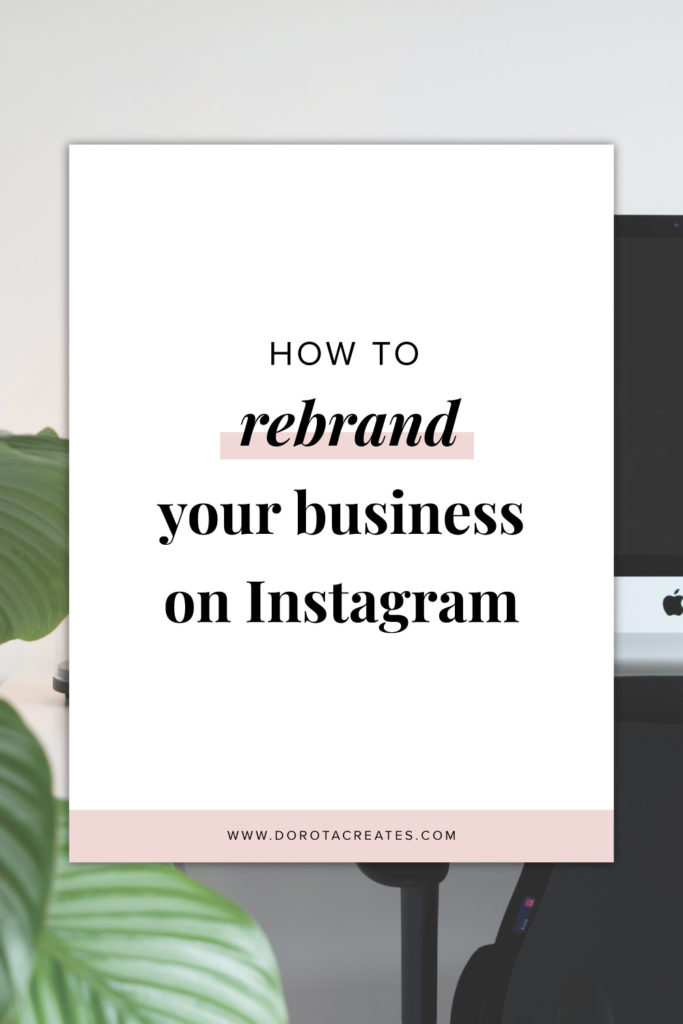
As a brand designer I meet a lot of business owners who feel that their brand is ready for a make-over. Normally this is because they have outgrown their current brand, or their business has taken a slightly different direction over the years. However, how do you rebrand yourself on a platform such as Instagram?
Rebranding on Instagram is best done by deciding who your target audience is and what their values are. After that it’s important to have a clear vision and mission for your business. From there on you can create a mood board, design the logo, fonts and colors that fit your target audience. Finally, you implement these elements in your profile, posts and stories on Instagram.
However, that certainly doesn’t tell the whole story. In this blog post I’ll take you through the six essentials steps that you’ll need to think about in order to successfully rebrand your business on Instagram. Whether you’re a coach with a small business or you have a complete brand already, all these steps will apply to you. Read on
1. Decide Who Your Target Audience Is
Rebranding is all about more effectively connecting with you target audience. Therefore, I suggest you always start off by deciding who your target audience really is and what the best way is to connect with them.
The reason for this is very simple: people want to do business with companies that connect with them on a deep level. If your brand is able to create connection with your target audience on an emotional level then you have rebranded successfully.
Now, since you’re looking to rebrand your business on Instagram there’s a good chance you already now who your target audience is and, more importantly, what attracts them to your brand and what they value in your service.
I encourage you to write down a few things about your target audience that are going to make this branding process a whole lot easier:
- Characteristics: female entrepreneurs between the age of 25 – 45 that own a coaching business
- Core Values: authenticity, authority, growth
- Goals: empower clients to facilitate growth
The reason why it’s important to know this is that all this information can help you rebrand more effectively and create a better connection with you target audience.
For example, aspects such as ‘female’ and ’25-45 years old’ are going to create different branding choices (e.g. shape, color, logo) than ‘male’ and ‘65+’ would do.
The same goes for the values and the goals: every chance inspires a different branding choice along the way and helps you establish an emotional connection more effectively. This creates a better brand connection and therefore more or better clientele. Think about adjectives that describe your brand and emotions you want your brand to evoke.
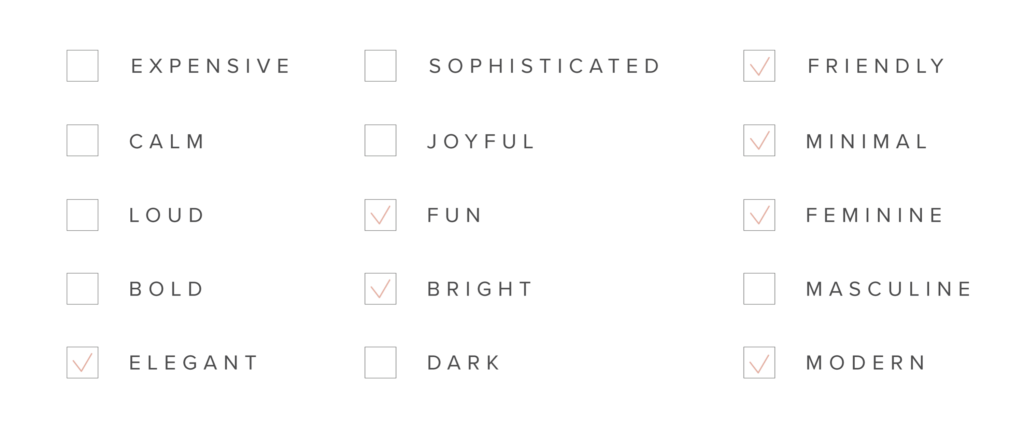
If you need help with establishing your target audience, your values and vision, download my free branding worksheet here. This will help you do exactly that in 10 minutes!
2. Think About What You Want To Achieve
If you want to rebrand your business on Instagram it’s important to continue by going back to the roots of your company. You have to ask yourself questions about what you intend to achieve with your business in the future and how you want to achieve that.
The reason for this is that the goal of branding is to connect with your target audience on an emotional level. A rebrand is only effective if you’re able to connect with your target audience and inspire them. People can only connect with your business and your brand if you have ideals, goals and visions. That’s why this step is so important.
Vision
Since you want to rebrand your business it’s important to make sure your vision is crystal clear. A vision is a short idealistic statement about what you’re trying to achieve with your business in an ideal world. It’s the heart and soul of your business.
If you don’t already have a vision this is the time to make one. You do this by figuring out 2-3 core values that you have in your business and combine them with your ideal view of the world if you’re able to reach this goal.
Let’s look at an example of an impactful brand and their mission statement. Let’s look at All Good Products, a company that produces environmentally friendly body care products:
“To harness the natural powers of the environment’s purest, most elemental ingredients and organic herbs in order to offer natural healing products that are good for people and good for the earth.”
In this statement you can clearly see some of the core values of the company. What stands out for me are the following: natural, harmony and environmentally friendly.
By taking these core values the business was able to create a statement that not only shows their goals and intentions but is also a guideline for their branding and something for their clients to connect too.
The reason why this is important for branding is because different core values and visions create different brand choices along the way. For example, a brand that has ‘strong’, ‘powerful’ and ‘raw’ as their core values is going to make use of different colors, shapes and logo’s than a brand that has ‘pure’, ‘love’ and joy’.
Mission
If a vision is the heart and soul of your business, then a mission is the personality that guides your choices along the way. The difference between a vision and a mission is that a vision is more of an idealistic goal for the future whereas a mission is the statement that describes how you’re going to get there.
It’s more concrete but from a branding perspective still very important. Reason being that elements from your mission statement can affect your branding in a lot of different ways and can be used as inspiration for the rebranding process.
Let’s look at an example of a mission statement from Futurpreneur, a Canada-based company that aims to stimulate and support young entrepreneurs:
“To provide early-stage financing, mentorship and other resources to help aspiring entrepreneurs age 18-39 launch successful businesses that contribute to sustainable economic development in their communities and for Canada.”
Not only is does this mission statement provide yourself with direction in your business (making it easier to make decisions) it’s yet another way for your customers to connect with you and your brand (which is the whole goal of rebranding).
3. Find Inspiration For Your Rebranding
Once it’s crystal clear for you who your target audience is, what you’re trying to achieve with your business and how you’re going to do that it’s time to get into the ‘real’ branding process. The preparation you’ve done so far should give you enough ammunition to start collecting inspiration for your rebranding.
The goal of this step is to get a rough idea of what your brand should look like. You do this by collecting examples of other brands which style attracts you. However, let it be clear that inspiration can come from anything, if you find images of interior designs or wallpaper that inspire you feel free to include them!
Also, and this is very important, keep in mind your target audience, vision and mission! There may be certain things that inspire you but may not necessarily attract your target audience. Including that would be a shame given that the whole goal of rebranding is to better connect with your target audience.
Make A Mood Board
In order for you to collect your inspiration in an ordered fashion I advise you to make a mood board. A mood board helps you collect your inspiration in one place while also limiting the amount of inspiration that you can include (to make sure you don’t spend endless amounts of time here).

Finding inspiration for you rebranding is the fun part! Personally, I like to use different websites for this. Instagram itself can be a great tool and, since you’re trying to rebrand on this platform, it may be wise to start there.
Other sources of inspiration that I frequently use are Pinterest, Dribbble and different kinds of magazines (fashion and interior design ones are great).
Things that you should keep an eye out for are which colors you think connect best with your target audience, what shapes you feel represent your business best and what fonts appeal to you and your audience the most (this is also very important for the rebranding of your logo which we’ll talk about in a minute).
4. Create The Framework
Once you’ve got your inspiration gathered it’s time to start creating the framework of your new brand. Since you’re looking to rebrand on Instagram it’s important to create or pick the following elements: logo, colors, fonts.
Now, let it be clear that there’s no exact way to go about this. A creative process can be messy and there’s a good chance you’ll go back and forth between elements. Personally, I like to start with the logo and work from there.
Furthermore, let it be clear that this process can take a lot of time and that the results can vary greatly based on your creative skills. If you’re a busy business owner or you’re not so sure about your creative abilities, it may be worth getting in touch with a brand designer. I would be more than happy to brainstorm with you about your new brand! Click here for more information about rebranding.
Logo
I like to start of with the logo because a good logo combines all branding elements and therefore gives a clear direction for the rest of the rebranding. If you’re rebranding there’s a good chance you already have a logo.
Now, you can do two things: start from scratch or use existing logo elements to use as inspiration for your rebranding. For example, if you have a specific symbol that’s synonymous with your brand than it may be worth keeping that symbol.
However, do keep in mind that everything you create has to be connected to your target audience, mission and vision. This is something that keeps on coming back over and over again.
From there on, creating a logo is a lot of brainstorming and trying in design tools. Personally, I like to use Adobe Illustrator for this purpose since it provides the most flexibility. However, when you try to go at this alone than Canva can also be a possibility (although it may not allow for the customization you would like).
It’s best to create a few variations of your logo: primary, secondary and a submark. The submark should have the least elements so that it looks great in a small format. This makes this logo variations the most useful on Instagram (e.g. you can add it to every post picture to “sign it” and keep your branding consistent.
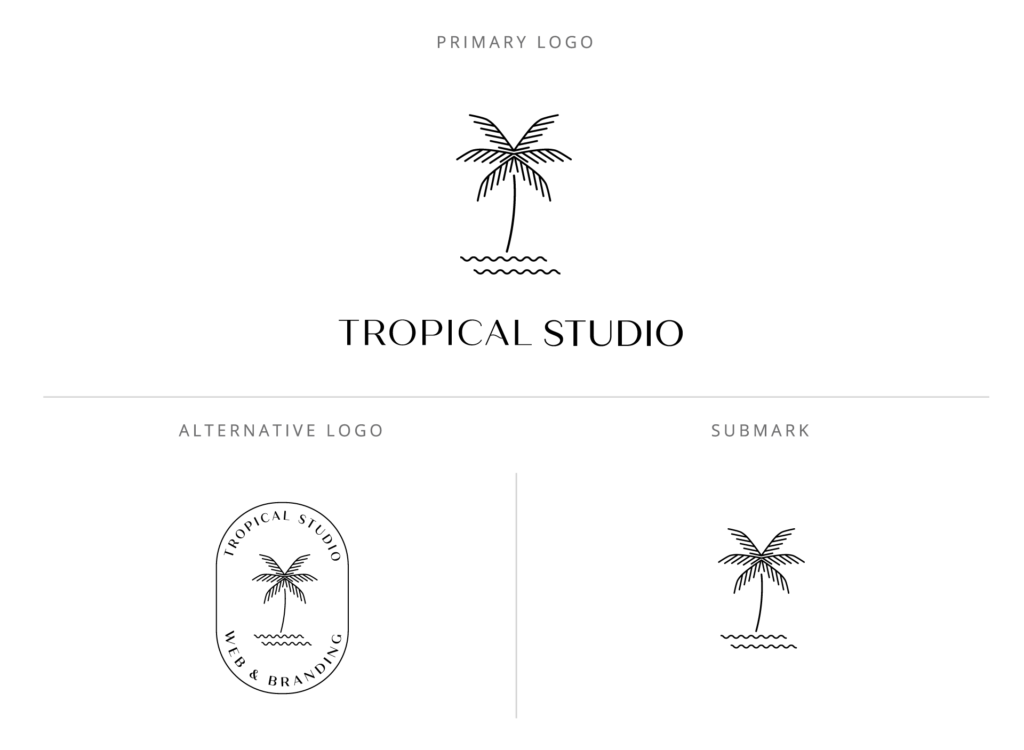
This is of course also the step where your mood board will be extremely useful, try different patterns, fonts and arrangements to create a logo that appeals to you and your audience the most. Let me clarify a bit more how to use colors and fonts in this step.
Colors
Now, colors can make or break your rebranding. As you probably know colors have strong associations with different emotions and it’s probably a good idea to match these colors with the core values of your audience and your business.
For example, a lot of female brands make use of pink because it’s generally considered to be a more feminine color. That’s certainly a color that wouldn’t appeal to a male-oriented audience. The same goes for black, which is generally used for luxury brands whereas light blue would be a strange color for this type of brand.
Below, we’ve created an outline of each color and what they generally reflect:
- Black: sophisticated, edgy, luxurious, modern, powerful
- Brown: old-fashioned, earthy, rugged
- Dark blue: security, formal, mature, trustworthy, professional
- Gray: classic, serious, mature, neutral
- Green: prosperity, growth, nature, stability
- Light blue: openness, peace, innocence
- Orange: vitality, friendliness, energetic, playful
- Pink: innocence, youth, feminine
- Purple: creativity, luxury, royalty
- Red: excitement, anger, passion, importance
- Yellow: happiness, optimism, youth, affordable, attention grabbing
- White: cleanliness, simplicity, pure, virtue, health
When choosing your colors, I advise you to pick three different colors to start with. Those are as follows:
- Primary color: used for your call-to-action buttons and generally the most attention-grabbing color of them all. All other colors are selected based on how well they go with this color.
- Secondary color: a color that goes well the primary color and that serves to accentuate it. Can be used as a frame on your Instagram posts or used for complimentary graphic elements.
- Neutral color: generally, a light color such as light grey, white, beige that’s used as the background in Instagram posts. Supports the other colors but doesn’t attract attention by itself.
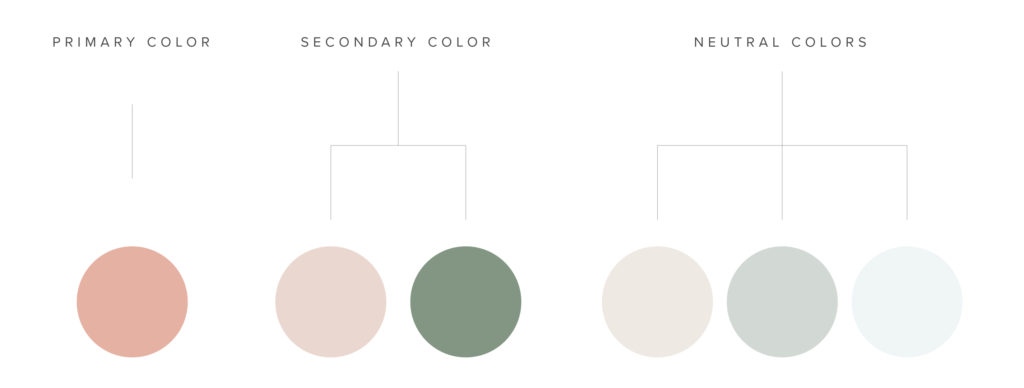
Once you’ve got your colors all set and done, they are a great branding tool to use in your posts and stories as long as you use them consistently.

Fonts
The final branding element you’ll have to decide upon is the font(s) that you want to use. Again, this is an element that can already come up during the design of your logo or it can be done later if your logo is just a symbol.
On Instagram, these fonts are used when you create your posts and your stories. Please be aware that you can’t upload your own fonts on Instagram (for example for your stories). If you create posts for Instagram you’re best advised to use Canva or Adobe Illustrator and upload your fonts there.
If you pick a font that isn’t supported by Instagram Stories than the best thing you can do is select a font that looks most similar and use these throughout your stories. For the posts you can still use your own font.
When selecting a font it’s once again important that this fits you target audience, vision and mission and the rest of design elements. If you want to select fonts yourself it’s good to know that there are certain font categories you can pick from.
To make your life a little easier we’ve created an outline of the six most popular font categories below together with the ‘personality’ traits that are normally assigned to these fonts.
- Serif fonts: classic, traditional, and trustworthy
- Sans-serif fonts: modern, clean
- Slab serif fonts: bold, quirky, and confident
- Script fonts: elegant and unique
- Handwritten fonts: informal and artistic
- Decorative fonts: stylized, distinctive, and dramatic
To give your branding even more character you can also opt to use two different fonts in your design (whether that be your logo, post or stories). If you do so I advise you to use fonts from the same category (as listed above). Each category has many, many fonts to chose from and you can play around with this yourself to see what fits your brand best.
While doing this, also decide what’s going to be your ‘main’ font (the one you use for headers) and your ‘secondary’ font (the once you use for text and callouts. Having a clear hierarchy is important for consistent branding.
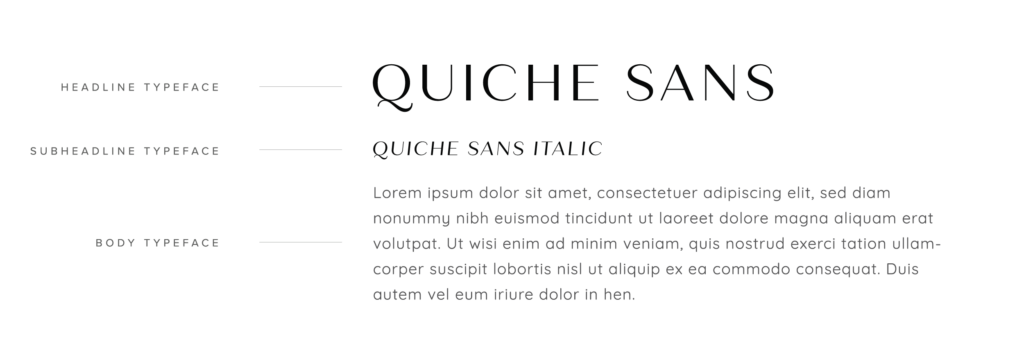
5. Announce The Rebranding
Now, before you start rebranding your Instagram account immediately It’s also important to take into account the audience that you already have. If your business doesn’t already have a substantial following, or almost no following at all, then rebranding can be as simple as ‘just implementing it’.
On the other hand, if your business does have some sort of following it’s important to prepare people for the changes that are about to come. Just like humans, your customers have most likely created a bond with the old brand and changing it without any form of heads-up could be disliked.
You can make this process as long or short as you would like to be. However, in my opinion the easiest way to announce a rebranding is by taking your current customers along for the right.
What I mean with that is that it can be wise to share updates about your rebranding on Instagram while your going along. You could even go as far as asking people with fonts and colors they like best (do give them a few options do).
This will not only prepare people for the changes that are about to come but will also get them emotionally involved in the rebranding. This will not only make them embrace the new brand but become an actual advocate for it because they will feel they’re part of it.
In general, it could be a good idea to start with this process a few weeks in advance or when you feel you have gone through step 1-3 of this blog post and are ready for step 4.
6. Change Your Instagram Profile
Once you’ve gone through all the above steps you’ve basically ready to start rebranding. If that day has finally come for you, I advise you to implement the rebrand all at once.
Don’t change your logo first, and then the font a few days later. Just do it all at once and, if you want to bring some attention to your brand (which I’m sure you do) share the heck out of it on Instagram to make it some sort of a ‘launch’.
Below I’ll walk you through a checklist of what you should change exactly on your Instagram feed (and what you should have ready on the day of your launch).
- Profile picture: your new logo should be ready to go. On Instagram this will display as a 110 x 110 px image but I advise you to create the logo in 1000 x 1000 px since this will display the image in higher quality on Instagram itself.
- Title: Assuming your core business didn’t change a lot you can leave this the same (If you liked what you had written). Make sure that this part of your profile immediately makes clear who’s profile it is (e.g. your brand name) and two to three words of what you do (e.g. natural beauty products, website design etc.)
- Description: this is where your vision and mission come in handy. This is the place where you explain ‘what’ you do, ‘how’ you do, and ‘for who’ you do it. If you have a business that’s very idealistic you can also use this space to go more in the direction of a vision and explain what you want to achieve.
- Posts: Assuming your rebranding is a slight directional change, and not a major overhaul of your target audience and goals, you can opt to leave the posts that you already have on your Instagram account. However, it is smart to have the posts for the upcoming weeks or month planned out already. This makes sure you have enough content already to fully implement your rebranding in the upcoming time period.
Furthermore, you can also ‘plan’ your Instagram feed. By doing this you make sure that all the posts connect (or that your feed shows an occurring pattern in terms of shapes or the colors that are used). - Stories: The same goes for your stories. You don’t have to plan these out weeks or a month in advance but it’s wise to at least have the rebranded story ready for you launch day.


